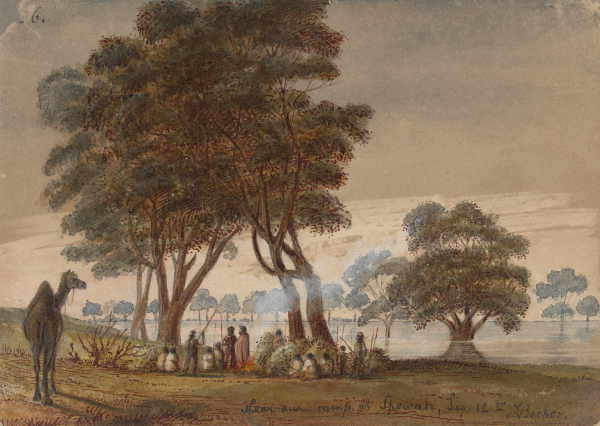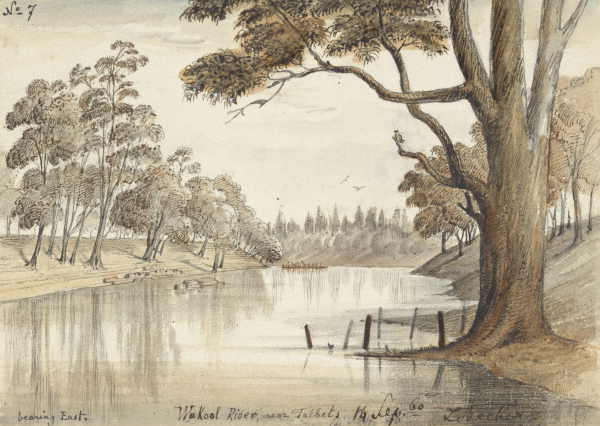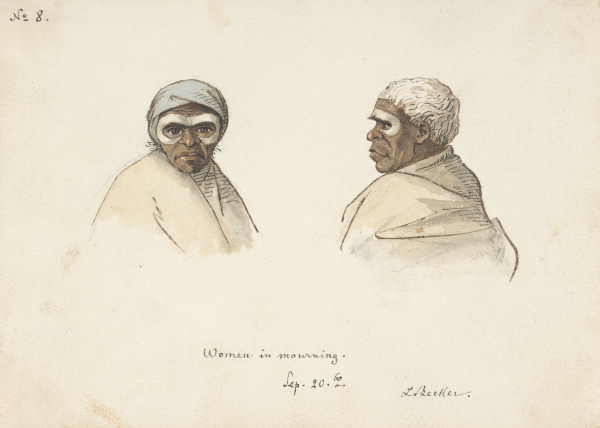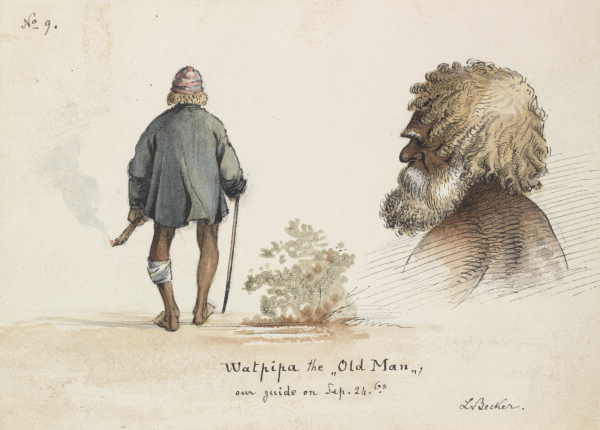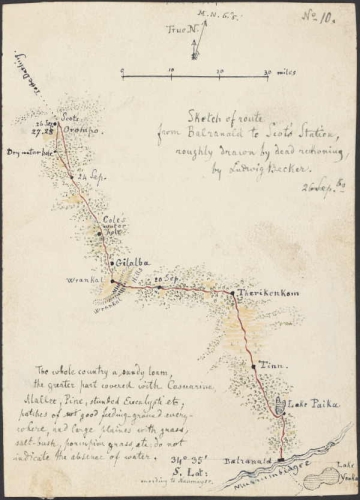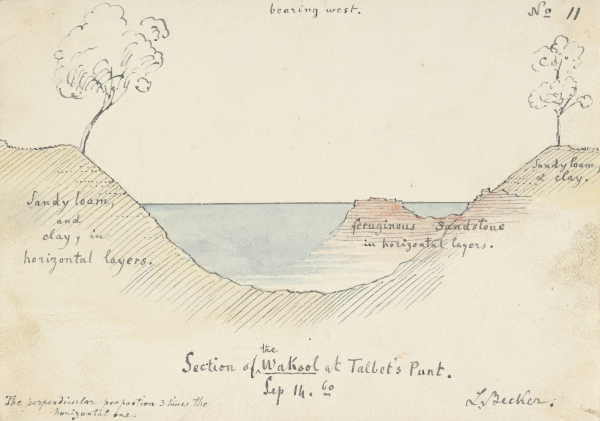|
Friday, 7 September 1860.
Soon after sunset a well defined Zodiacal light was observed in the West; to the South an Aurora australis stretched its rays as far as Nebula major; in the North sheet lightning continually illuminated the horizon. From the star Vega at 7h.15m p.m. a brilliant shooting-star fell nearly perpendicularly, apparently into the electrical discharges disappearing about 9° above the horizon.
Saturday, 8 September 1860.
During the night strong wind and rain. Engaged with writing, and doing duty in the camp.
Sunday, 9 September 1860.
Three of the hired waggons arrived today in the camp; they were detained on their way -after leaving us at Inverness Inn -in consequence of the bad roads.
Monday, 10 September 1860.
Send letters etc. to post. Numbers of inhabitants from Swan Hill visit our camp. Professor Neumayer arrived today.
Tuesday, 11 September 1860.
Ladies and Gentlemen from Swan Hill gave the officers of the Exploring Party a parting dinner and if all the kind wishes we here received are destined to be realised, surely our trip through New-Holland and back again will he anything but a dangerous one. To Mr Superintendent Foster and to Dr Gummow I am very much indebted for a number of things I was in need of and which I have not received in Melbourne, although so much required for preserving objects of natural history. In the afternoon we crossed the Murray and camped there in sight of Swan Hill.
Wednesday, 12 September 1860.
A number of the good people from that township came over to New-South-Wales to bid us a final Farewell, and with a hearty 'Hurrah' away we went and arrived after a 13 miles march at Speewah an out-station of Mr McKenzie. The hut is beautifully situated close to a backwater of the Murray. A native camp full of Blacks was near the spot where we commenced pitching our tents. The natives did not deem it prudent to remain so close to us and notwithstanding our assuring them that they had nothing to fear, they removed their children and chattels a hundred yards away and, contrary to their custom, here they lay silent and concealed during the calm night, not even attracted by the produce of our cooks skill. I made a sketch of the native camp and the scenery around it, as shown in drawing No 6."
Thursday, 13 September 1860.
Marched at 8¼ a.m. When some distance from our late camp we observed, ahead of the caravan, extremely well mounted on horseback and dressed in a black riding-gown -a Lady, rather a strange thing in such an out-of-the-way place. Approaching her we found it to be the daughter of the hut keeper and ready to show us the track, although not asked to do so. After some time and when her horse was somewhat accustomed to the camels she went along side 'Bunjib' -the name of my camel -and I was surprised during the conversation to find her a well educated and well informed person, from whom I gathered not a few valuable observations in natural history, made by her at her parents lonely place, or in the surrounding primitive forest. We came after 13 miles ride to Mr McKenzie's head-station, where we learned that Miss Ann Jane Jones' father was then and there a respectable shepherd and that he has been formerly Acting Governor of Fernando Po ! -Mr McKenzie was very sorry to learn that the Exploring Party did not intend to stay overnight at his place, however, man and beast were well received and provided for by that Gentleman, and after an hours spell we left at 1¼ p.m. for Boon-Boon, distant 6 miles, where we arrived at 4 p.m. Here Mr Burke rejoined us, having been detained on business at Swan Hill. We were ordered to go on as far as Talbet's punt on the Wakool river and arrived there at 8 p.m. distant 10 miles from Boon- Boon. To day we travelled 29 miles, but the waggons were left behind, the sandy road not permitting them to keep pace with the camels. Lighting several fires we slept along-side them, not at all the worse for being left without tents and edibles; with a supper, however, we were provided from the public house on the other side of the Wakool. All the afternoon and the greater part of the night it blew very strong, and I was somewhat afraid when I saw the old trees near the camp shaking their rotten branches and the ground already strewn with dead timber.
Friday, 14 September 1860.
I had the morning watch from 1 to 3 a.m. and although the sky was clear I did not observe a single shooting star, in fact I have noticed only one or two during the last three weeks, notwithstanding my watching the clear sky many an hour at night. When day broke I hastened to the Wakool not far from our resting-place. The banks of this river appear as if dug and cut by human hand, presenting the appearance of an artificial canal. The banks slope down to the river at an angle of about 40 degrees for many miles below and above the point where we crossed. A section of the watercourse, near the punt, will show what I mean. (See Sketch No 11). Here the river is 80 yards wide and its average depth Is 20 feet, but at some time it is double that the figure. The current is very slow I found it to be only 15 feet during a minute. The banks are composed of clay and loam but at one spot, near the crossing point, a coarse sandstone of a dark-red and purple color is visible and shows its face also above the level of the river, some distance from the bank. (See Sketches No 7 and No 11). I collected here several species of fresh water shells, one of which seems to be new. It took four hours to cross the Wakool and not before 1¾ p.m. we were able to leave Talbet's, halting for the night at a plain, which we reached after 3 hours marching. We made only 9 miles today, through a country first covered with pine and afterwards with Mallee. Fine weather all day long.
Saturday, 15 September 1860.
At 8¾ a.m. we marched away and soon found ourselves in a fine forest of tall Gumtrees. Here a great number of white Cockatoos had there home but greatly disturbed by the appearance of the camels. The birds flew about with all signs of fear or curiosity and their screaming was anything but pleasant. Ten and a quarter mile distant from our last camp and in a N.E. direction from it a fresh water lake was seen which turned out to be Lake Yanke. It has the form of the number 8 and is 8 + 4 miles long. Between this lake and the Murrumbidgee, which is 4 miles from the Yanke Lake, several indentions in the country are visible, and the Murrumbidgee, then bank high, had filled the same, creating creeks and lakes, which we with some difficulty crossed, the water being on some places four feet deep. After this we at 4 p.m. saw ourselves on the banks of the Murrumbidgee awaiting the approach of a wretched punt from the other side of the river on which the township Balranald is situated. This day we had travelled 18 miles
Sunday, 16 September 1860.
Balranald is in Lat 34°.35', a township of about 24 buildings, such as a Store, Hotel, Black Smith shops etc:, the building material is bark and timber, calico and paper. Five of our waggons were left behind yesterday on the left bank of the river, today they crossed with some difficulty and danger. Mr Burke held a consultation with the officers of the expedition and it was considered prudent to leave some of our stores behind at Balranald. |
|



